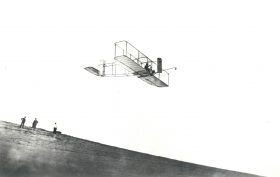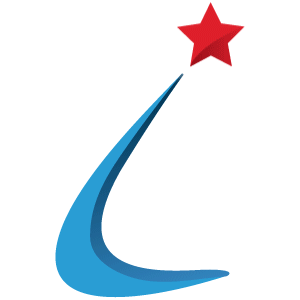PART 1: A CHILDHOOD OF CURIOSITY
Orville and Wilbur Wright were born four years apart, in different cities. They shared a curiosity about the world and a love of tinkering that would make history.Wilbur was born in 1867 on a small farm near Millville, Indiana. Orville was born in 1871 in a house in Dayton, Ohio. Their father was a Bishop in the Church of the United Brethren in Christ. (The Wrights had five children in all: Reuchlin, Lorin, and Katharine were the names of the other children.)
Life in the Wright house was strict but loving. Both parents encouraged their children to enjoy school and learn as much as they could. A large library of books about all kinds of subjects helped the Wright children quench their thirst for knowledge from a very early age.
Orville and Wilbur's fascination with flight began with a present their father gave them - a flying toy. It had a paper body and other parts made of cork and bamboo. Rubber bands provided the power. The young boys (7 and 11) were thrilled to make the little toy fly across the room, so much so that they broke it. They remembered how it looked, though, and promised each other that someday they would fly in the air, just like the little toy.
The boys continued to be interested in mechanical things and flight. Orville sold kites at school to make money. Wilbur started reading all he could about how birds flew and machines worked.
Though the boys were good students, neither graduated from high school. (Not many did in those days, actually.) Wilbur was hit in the face with a baseball bat when he was a teenager and suffered from irregular heartbeats the rest of his life. He stayed at home for a while, during which time their mother developed tuberculosis (which, at that time, was a devastating disease with no known cure). Wilbur recovered himself and then stayed at home to care for his mother. Orville left high school on his own, to start a printing business. He and Wilbur designed a printing press that worked very well. The two later sold the printing business and opened a bicycle shop. They were both very good mechanics and could fix just about anything anyone asked them to fix. (They inherited this skill and desire from their mother, who was the family mechanic.)
It was in the bicycle shop that the idea of the airplane was born. One day, Wilbur squeezed an empty bicycle tube box flat. He noticed how it looked when he twisted in his hands. (The flattened box is the exact shape of the two-winged glider that the Wrights would produce just a couple years later.) They also used a bicycle chain as a propeller on their plane. (It should be pointed out here that the Wrights had to invent the propeller as a means of propulsion.) The double-triangle design of the plane also looks a lot like a bicycle.
And one day in 1902, Orville and Wilbur took turns pedaling one of their own bicycles down a city street as fast as they could go - with a third wheel attached in front. The wheel was mounted flat on the handlebars. It spun freely, with two metal plates on top of it. One plate was flat, and the other was curved. This setup allowed the Wrights to measure air resistance, another key to building an airplane that would work.
The Wrights had also made kites, very large ones, in fact. By 1900, they were making ones so large that people could fly in them, sort of. These were called gliders, and Orville and Wilbur actually built one or two that were large enough for a person to ride in. They flew on nothing but air current, and the person could get a ride of about 10 seconds before the glider came down to the ground.
PART 2: PERSISTENCE TO SUCCESS
The Wrights wanted more, of course, and built a better glider that had a rudder, to steer with. One of their gliders stayed aloft a time, flying more than 600 feet. But they still came down, no matter what the person aboard did. The Wrights wanted to make a machine such that the pilot could control when the machine would land.They had thought of engines, of course, like the ones in factories. But these engines were much too big. Orville and Wilbur finally decided to make an engine that would be small enough and light enough to power one of their gliders. With their mother's love of tinkering and their own curiosity driving them, they made an engine that would fit the bill and installed it on their newest glider.
The Wrights had chosen Kitty Hawk, North Carolina, as a place to test their plane. This spot had lots of wind, and it had a large sand dune that would hopefully catch the plane if something went wrong. They had been coming to Kitty Hawk for a few years, testing gliders and other ideas. They had built more complicated machines all the time.
So it was on December 14, 1903, that Wilbur Wright made the first experiment with the new man-powered airplane flight. The flight didn't last long and ended in a crash, which took the Wrights a few days to repair. And it is worth noting that the plane got up its momentum on this attempt by gliding down a monorail from the top of a hill. (The plane had wheels, remember, and so it rolled down the rail, just like a bicycle.)
Wilbur was the pilot that day. The brothers had flipped a coin to see who would go first.
After repairing the plane, Orville and Wilbur decided to put the track on flat ground. This would allow Wilbur to run alongside the plane as it was gaining speed and keep the right wing steady. (Because the plane had been going downhill on the first attempt, Orville couldn't keep up and so Wilbur had had to try to steer the plane himself. Not being familiar with how to do such a thing, Wilbur steered too much and the plane quickly hit the ground.)
With the coin flip results intact (meaning that it was Orville's turn to fly), the little plane was launched on December 17. Wilbur pushed, Orville pedaled, and the plane rose in the air. It was only aloft for 12 seconds and went 120 feet, but it was official: The Wright brothers had a machine that could fly.
PART 3: A LEGACY IN THE AIR
They flew the machine three times that day, mainly because each time they managed to land without crashing. Each flight was a bit longer, and the final flight of the day carried Wilbur 852 feet. He was in the air for a full 59 seconds.The Wright plane wasn't a hit overnight, however. No one else knew about the flight. The brothers returned to their bicycle business in Dayton and also continued to refine their airplane invention. Not long after that, they had built a plane that could fly 25 miles and go 40 miles an hour. They even had a model that could fly circles in the air - and not go off-balance and crash to the ground!
In 1908, Wilbur flew one of their planes in front of royalty in Europe. In the same year, the rest of America discovered the airplane when a newspaper reporter witnessed a flight and wrote about it. The story was soon in newspapers all over the country. The Wrights were suddenly famous.
The very next year, they opened a business to make airplanes, the Wright Company. They found great fame and success making airplanes. Unfortunately, Wilbur died in 1912 of typhoid fever. Orville lived on, however, eventually selling his business and watching his and his brother's dream become a reality in the modern industrial age





